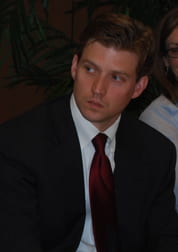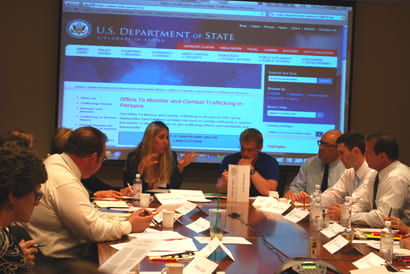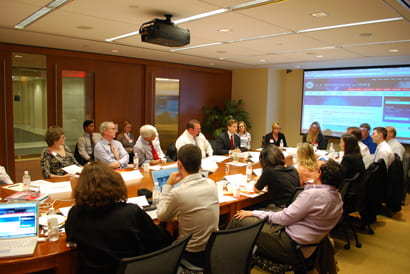 State Department and Congressional policymakers, along with nongovernmental organization and technology industry leaders convened in Washington, D.C. Thursday, June 3, 2010 to explore new ways communication technology might be used in global efforts to combat human trafficking.
State Department and Congressional policymakers, along with nongovernmental organization and technology industry leaders convened in Washington, D.C. Thursday, June 3, 2010 to explore new ways communication technology might be used in global efforts to combat human trafficking.
The meeting held at the USC Washington, D.C. Center was organized by USC Annenberg’s Center on Communication Leadership and Policy in partnership with assistance from the U.S. Department of State. Geoffrey Cowan, CCLP director and USC University Professor, co-chaired the gathering with Alec Ross, Secretary of State Clinton’s senior adviser for innovation (pictured right).
Ross opened the meeting with remarks about 21st Century Statecraft, a concept introduced by Secretary Clinton that acknowledges the complexities of globalization and the proliferation of new technologies.
 He posed questions as to what the role of new technologies should be in responding to global crisis, as well as the role of public-private partnerships. Using the recent disaster in Haiti as a launching-point, Ross asked how technology might be best utilized to connect governments to people, people to people, and people to governments. He explained that text-messaging projects were implemented immediately following the earthquake, raising millions of dollars for the relief effort and building public awareness about the disaster; however, these types of coordinated efforts have not yet been effectively undertaken to combat trafficking in persons (TIP). USC Annenberg‘s role, he stated, would be to act as a “convener outside of government;” a safe and dynamic space to bring together people who can tackle TIP related issues in new, innovative ways.
He posed questions as to what the role of new technologies should be in responding to global crisis, as well as the role of public-private partnerships. Using the recent disaster in Haiti as a launching-point, Ross asked how technology might be best utilized to connect governments to people, people to people, and people to governments. He explained that text-messaging projects were implemented immediately following the earthquake, raising millions of dollars for the relief effort and building public awareness about the disaster; however, these types of coordinated efforts have not yet been effectively undertaken to combat trafficking in persons (TIP). USC Annenberg‘s role, he stated, would be to act as a “convener outside of government;” a safe and dynamic space to bring together people who can tackle TIP related issues in new, innovative ways.
 Following Ross, Ambassador Luis CdeBaca, director of the U.S. Department of State’s Office to Monitor and Combat Trafficking in Persons and Senior Advisor to the Secretary provided an detailed overview of the challenge (pictured left).
Following Ross, Ambassador Luis CdeBaca, director of the U.S. Department of State’s Office to Monitor and Combat Trafficking in Persons and Senior Advisor to the Secretary provided an detailed overview of the challenge (pictured left).
Pointing out that human slavery is not a new problem, the Amb. CdeBaca identified three main issues that he hoped the meeting would address: demand, victim-care, and the ethical use of technology.
In regard to demand, Ambassador CdeBaca stated that [in both sex and labor trafficking] there is a need to “clean up the supply chain”; potentially using technology to “name and shame” those who perpetuate related crimes.. About victim-care, he reminded participants that vulnerability and victimization come in many forms: from economic and gender-based forms of discrimination, to mental illness and situations of domestic abuse. He noted the need to create jobs to provide to victims of human trafficking during their rehabilitation. Finally, in regard to technology and ethics, the Ambassador reminded the group that many new technologies are, in fact, created using exploitative labor and human slavery. We have an obligation, he said, to know how our technology is being made and to make sure it is created under ethical conditions.
 Cowan moderated a focused and engaged discussion in which he asked participants to describe ground-level view of conditions in various countries as they pertained to trafficking in persons. The needs of victims, service providers, and policy makers were considered. Of particular interest were the types of social support services available to victims and the steps that many organizations have already taken to integrate new technologies into their efforts.
Cowan moderated a focused and engaged discussion in which he asked participants to describe ground-level view of conditions in various countries as they pertained to trafficking in persons. The needs of victims, service providers, and policy makers were considered. Of particular interest were the types of social support services available to victims and the steps that many organizations have already taken to integrate new technologies into their efforts.
Amy O’Neill Richard, Senior Adviser in the State Department’s Office to Monitor and Combat Trafficking in Persons (TIP) described a national trafficking hotline that has been implemented with support from Lexis Nexis, while Eric Beinhart of USAID described an effort led by Microsoft to educate the public and isolate predators through gathering and sharing case data about child exploitation and trafficking. Several participants spoke to the idea of empowering community members through implementing SMS texting and crowd-sourcing technology.
Participants also identified key problems and discussion topics related to trafficking in persons, and asked technology experts to respond to these issues as they were introduced.
Some of these problems/discussion topics included: the use of anti-phishing/spam to be used to address labor trafficking issues; tracking illegitimate websites and job offers through a “TripAdvisor” for jobs model; the systemization of border patrol and better training of law enforcement officers (particularly in the developing world); links between trafficking and disease; the use of Google mapping or satellite imagery to combat TIP; making information about human resources more readily available and accessible in an effort to prevent TIP; using technology to track transit routes; making SMS transactions more accessible; creating a unified system for capturing data on trafficking-related criminal cases country-to-country; accurately counting and representing victims; using photography as a tool to combat TIP; capturing and organizing data about perpetrators [across the sex trafficking exploitation chain] (traffickers, pimps and johns); unified legal oversight and prosecution across sovereign borders; and how technology can help service providers implement and share best practices.
Ross concluded the meeting by calling on the group to remain engaged and be opportunistic as ideas emerge. The State Department will consider the ideas presented and encourage further exploration. CCLP will continue to act as a convening agent to keep the group and other individuals connected in order to collaborate on these and other issues.

For more photos from the working group, visit the CCLP Collection on Flickr.